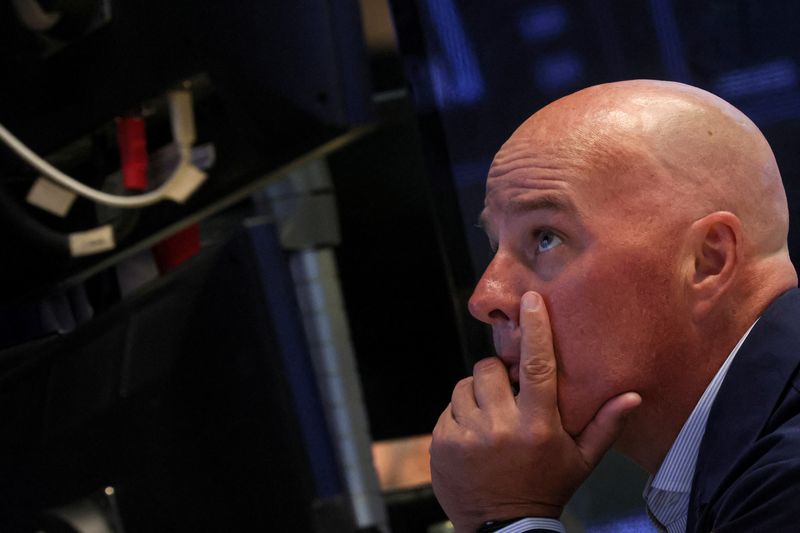By Lewis Krauskopf
NEW YORK (Reuters) - U.S. stocks are looking expensive again to some investors, as the Federal Reserve’s hawkish message lifts bond yields and pushes market participants to reassess equity valuations.
The S&P 500’s forward price-to-earnings ratio, a common metric for valuing stocks, has crept back up to around 17 times earnings after a sharp rebound in equities from their mid-June low.
That valuation - far below the nearly 22 times forward P/E stocks commanded at the start of the year - may have seemed reasonable earlier this month, when markets were rallying on hopes that the Fed would end its monetary tightening sooner than previously anticipated.
Fed Chairman Jerome Powell all but crushed those hopes with an unambiguously hawkish message at last week’s Jackson Hole conference, and some investors now believe stock valuations may have to fall further to reflect the risks of rising bond yields and a looming recession.
Comparatively modest valuations were one of the biggest positives the market possessed at the end of the second quarter, when stocks stood near their lowest levels in 1-1/2 years after a six-month shellacking and forward P/E hovered at just above 15 times, said Matthew Miskin, co-chief investment strategist at John Hancock Investment Management.
After rallying 10% from their mid-June lows, stocks are "not pricing in as much risk, and that is something that the market is going to have to grapple with as we get through the back half of 2022,” Miskin said.
Among the dangers to equities is a rise in Treasury yields that has accelerated as investors come around to the idea that the Fed is determined to raise interest rates higher than markets had previously expected.
Climbing Treasury yields, which move inversely to bond prices, tend to pressure equities, in part because U.S. government bonds offer a risk-free alternative to stocks. Rising yields weigh particularly on valuations of companies such as those in the technology sector that have high expected future earnings and are significant parts of indexes like the S&P 500.
The mid-June low for the S&P 500 came as the yield on the 10-year U.S. Treasury note rose to about 3.5%, its highest level in over a decade. After sliding during the summer, the 10-year yield has rebounded to 3.1%.
As a result, the equity risk premium, the extra return investors expect to receive for holding stocks over risk-free government bonds, has recently fallen to roughly its lowest point since 2009, according to the Wells Fargo (NYSE:WFC) Investment Institute. Analysts there recommend that investors skew their portfolios away from equities and toward fixed income and commodities.
The stock market is "incredibly expensive when compared to the now-higher 10-year yield,” said Sameer Samana, senior global market strategist at Wells Fargo Investment Institute.
(Graphic: S&P 500 vs 10-year yield- https://fingfx.thomsonreuters.com/gfx/mkt/zjvqkbxgqvx/Pasted%20image%201661870867487.png)
The S&P 500 has fallen 5% since Powell’s speech on Friday, as investors adjust their expectations for how high the Fed will lift rates. The S&P 500 was down 0.9% on Tuesday afternoon.
“The market had too quickly priced in a soft landing and had little room for error left,” wrote Keith Lerner, co-chief investment officer at Truist Advisory Services. “However, even after the pullback, it’s too soon to say the risk/reward is compelling.”
Still, current valuations are at a “premium level” given uncertainty in the earnings outlook and continued monetary tightening, Lerner said in a note on Monday. Based on current forward earnings projections, Lerner estimates a decline in the S&P 500's P/E to 15 times would put the index at just above 3,600, around its June lows and equivalent to a drop of more than 10% from Monday's closing level.
To be sure, there have been compelling arguments for owning stocks in recent months.
A better-than-expected U.S. second-quarter earnings season, despite a cloudy economic outlook, helped fuel the recent rebound in stocks. S&P 500 earnings are now expected to rise about 8% in 2022.
But the profit outlook stands to weaken if the Fed raises rates so much that it results in a recession, as some investors expect. Data indicates more analysts are cutting earnings estimates as opposed to raising them, wrote Morgan Stanley (NYSE:MS) strategists, presenting another potential threat to valuations.
Troy Gayeski, chief market strategist for FS Investments, said he sees little reason to own most stocks as the Fed hikes rates.
"We are staying very defensive," he said. "It's an environment to protect capital."
